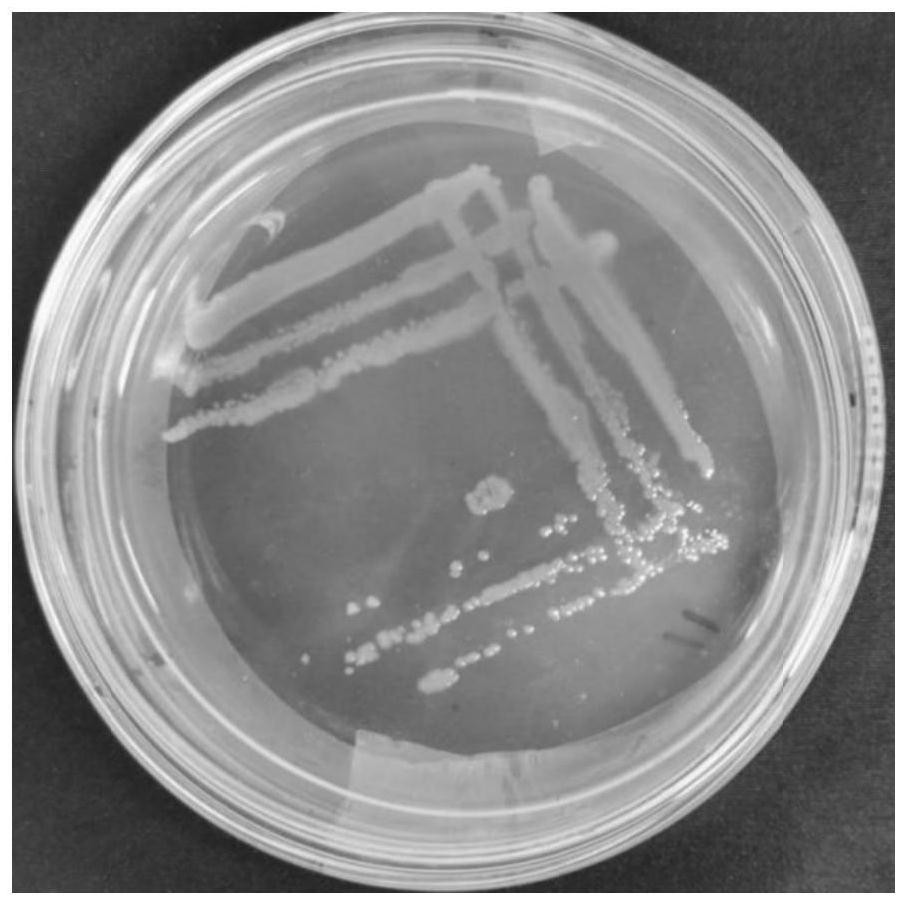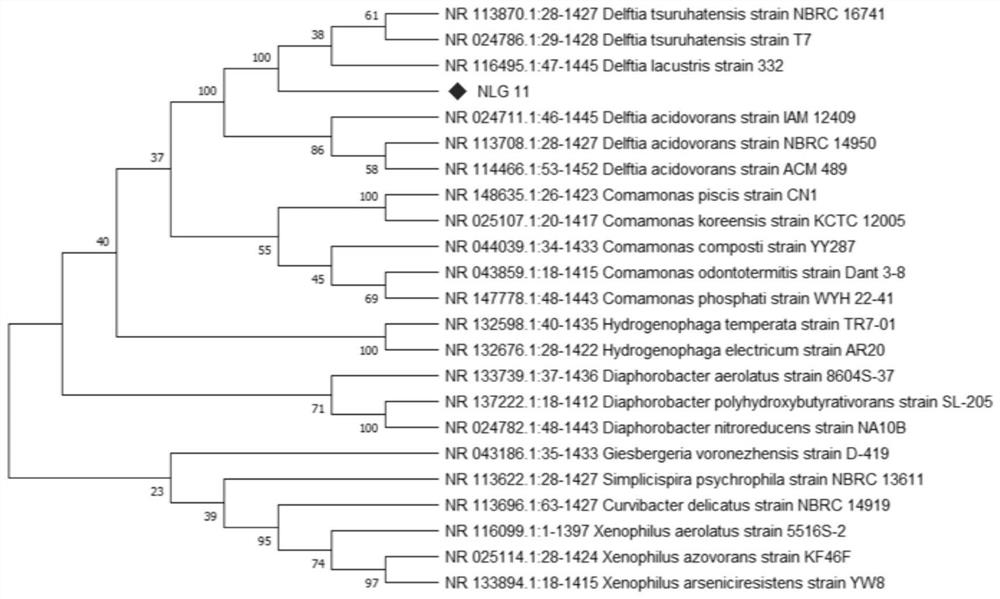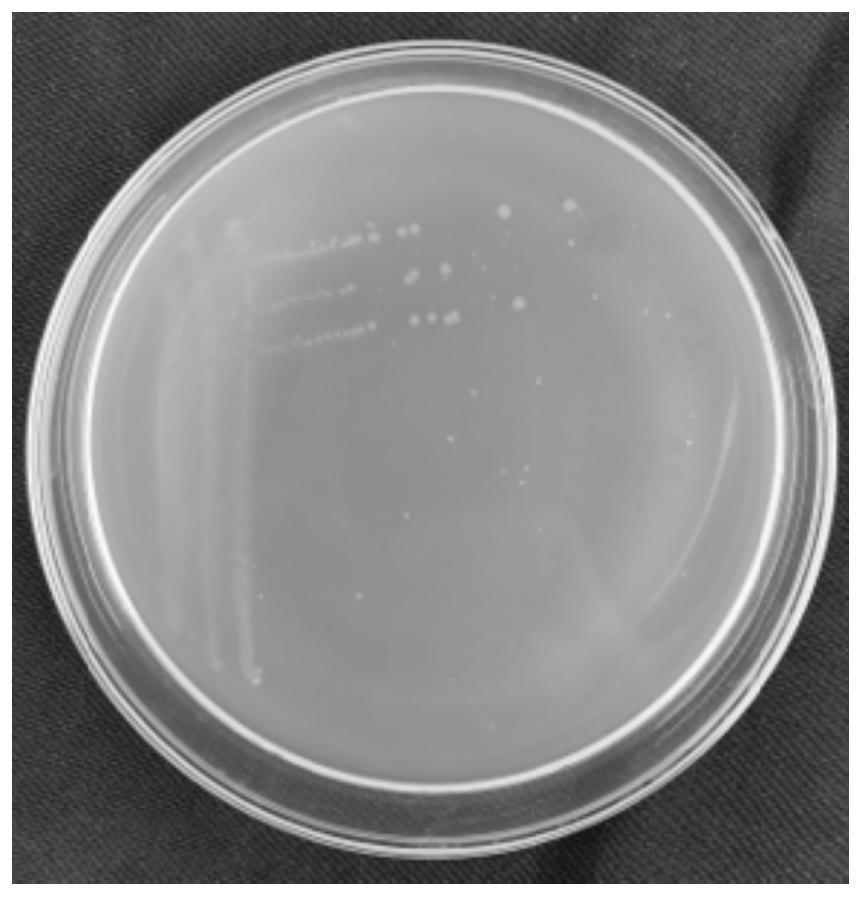Delftia sp. NLG11 for degrading tobacco nicotine and application of Delftia sp. NLG11
A technology of Delft bacteria and nicotine, which is applied in the field of agricultural microorganisms, can solve the problem of low initial concentration, achieve the effect of improving aroma quality, good application prospects, and reducing smoke concentration and energy
- Summary
- Abstract
- Description
- Claims
- Application Information
AI Technical Summary
Problems solved by technology
Method used
Image
Examples
Embodiment 1
[0036] The isolation of embodiment 1 bacterial strain
[0037] 1. Preparation of selective isolation medium
[0038] LB medium: 10g peptone, 5g yeast extract, 10g NaCl, 15g agar, dissolved in 1L sterile ddHO 2 O water, adjust the pH to 7.0.
[0039] EB medium: 3g beef extract powder, 10g tryptone, 15g yeast powder, 5g sodium chloride, 10g glucose, 15g agar, dissolved in 1L sterile water, adjust pH to 7.0.
[0040] NA medium: 10g tryptone, 3g beef extract powder, 5g sodium chloride, 15g agar, dissolved in 1L sterile water, adjust the pH value to 7.0.
[0041] 2. Bioassay and sampling
[0042]The 15-day rice with uniform growth was selected and divided into two groups with three replicates in each group, with 4 to 6 rice in each replicate. The rice seedling dipping method was used for the bioassay of brown planthopper: pull out the rice by the root, rinse it with clean water, and dry it in a cool place until the surface is dry. water, wrap the rice root with moist cotton, p...
Embodiment 2
[0047] The identification of embodiment 2 bacterial strains
[0048] 1. Colony Morphological Characteristics
[0049] From the morphological identification, after being placed on the LB plate in an incubator at 37°C for 24 hours, the colonies were round, flat, yellow, opaque, smooth in surface and regular in edges. This bacterium is facultatively aerobic, with an optimum growth temperature of 30°C and low nutritional requirements, and grows well on common medium LB.
[0050] 2. Determination of physiological and biochemical characteristics
[0051] The results of the physiological and biochemical properties of the intestinal isolates are shown in Table 1: for rhamnose, mandarin, amygdalin, arabinose, β-galactosidase, arginine dihydrogenase, ornithine Decarboxylation, citric acid, glucose, mannitol, sorbitol, sucrose can be utilized. Cannot decompose H2S, urease, tryptophan deaminase, indole, 3-hydroxybutanone, gelatinase, lysine decarboxylase.
[0052] Table 1 Physiologica...
Embodiment 3
[0062] Example 3 Screening of bacterial strain NLG11 in nicotine medium
[0063] Mineral salt basal medium (MSM): 13.3g K 2 HPO 4 , 4.0g KH 2 PO 4 0.1 g(NH 4 ) 2 SO 4 , 1.0g yeast powder, 10.0mL trace elements (1.0g MgSO 4 ·7H 2 O, 0.4g MnSO 4 ·H 2 O, 0.2g CaCl 2 2H 2 O, 0.2g CuCl 2 2H 2 O, 0.02g FeSO 4 ·7H 2 O, dissolved with 0.1mol / L HCl to 100mL), added distilled water to make up to 1L.
[0064] Nicotine medium: 90% nicotine is filtered with a 0.22 μm filter membrane, and added to the sterilized inorganic salt basic medium.
[0065] The activated NLG11 strain was plated on MSM solid medium supplemented with 200mg / L nicotine, cultured upside down in a 30°C incubator for 24 hours, and the growth of colonies in the petri dish was observed. The results were as follows: image 3 . Depend on image 3 It can be seen that the NLG11 strain can grow a single colony in the MSM solid with 200 mg / L nicotine added, and the colony is transparent.
PUM
 Login to View More
Login to View More Abstract
Description
Claims
Application Information
 Login to View More
Login to View More - R&D
- Intellectual Property
- Life Sciences
- Materials
- Tech Scout
- Unparalleled Data Quality
- Higher Quality Content
- 60% Fewer Hallucinations
Browse by: Latest US Patents, China's latest patents, Technical Efficacy Thesaurus, Application Domain, Technology Topic, Popular Technical Reports.
© 2025 PatSnap. All rights reserved.Legal|Privacy policy|Modern Slavery Act Transparency Statement|Sitemap|About US| Contact US: help@patsnap.com



